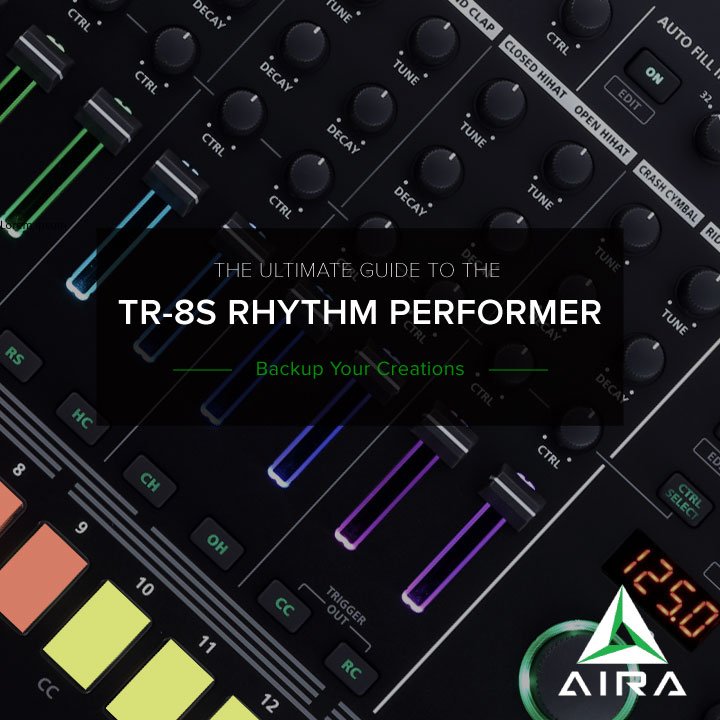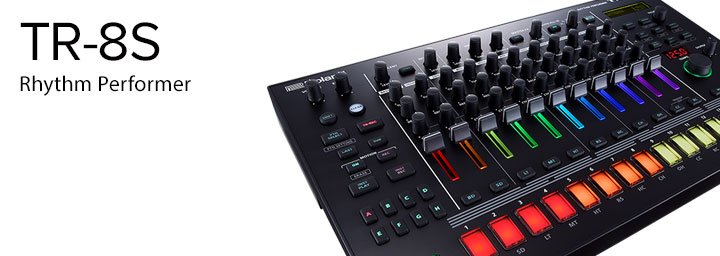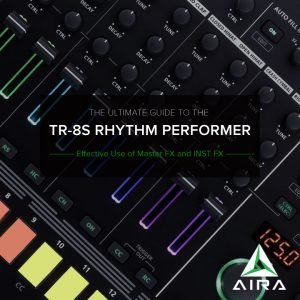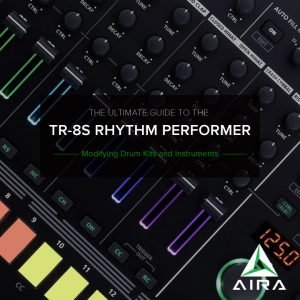The Roland TR-8S gives you 128 Kits and 128 Patterns, with 8 Variations per Pattern, 1024 Variations total. Even with that much capacity, once you get going with Pattern and Kit Creation, you’ll find it fills up, and before long it’s time for the all-important BackUp.
Before backing up your TR-8S, be sure to save any Patterns, Kits and System Settings that haven’t been saved. Patterns and Kits that have unsaved changes show an Asterix ( * ) to the left of the Pattern or Kit Number.
To Back Up your TR-8S:
- Press the Utility Button to view the Utility screen.
- Hold Shift and Turn the Value Knob to select UTILITY.
- Release Shift then turn the Value Knob to select UTILITY: Backup and press Enter.
- If a Back Up already exists, display shows ‘Save As’ – press Enter.
- If you want to create another Back Up, change the File Name, (for example make it ‘tr8s_bak2’ ) then press Enter.
- If there is already a File with the same name, display shows ‘Overwrite?’. If you want to overwrite the existing Back Up, choose [OK] and press Enter, if not choose [Cancel] and press Enter.
Restore a Back Up from SD Card
- Press the Utility Button to view the Utility screen.
- Hold Shift and Turn the Value Knob to select UTILITY.
- Release Shift then turn the Value Knob to select UTILITY: Restore and press Enter.
- Turn the Value Knob to select the desired File to Restore and press Enter.
- The Display shows ‘Restore?’ To Restore choose [OK] and press Enter. To cancel choose [cancel] and press Enter.
Working With TR-8S Data on Your Computer
When the SD Card is mounted on a computer, in the SD Card Volume on your desktop, there is a folder called ‘BACKUP’. To back up your TR-8S data to your computer, copy the BACKUP Folder to another location. One approach is to create a folder on your computer called ‘Roland TR-8S’. In that folder create another folder and name it for the current date, then copy the BACKUP Folder on your SD Card to that folder. Create another folder, named for the current date, every time you do another back up on your computer from the SD Card. This way you will easily be able to go back to your material from any given time period.
You may also want to name back up folders on your computer for the name of a song or project which uses that TR-8S data.
PRO TIPS
One very handy thing about looking at your Back Ups on the computer, is the Back Up Text File. In the BACKUP folder every Back Up includes a text file which lists detailed information regarding all the Patterns and Kits in that Back Up. If you name your Patterns for the Song and Section, for example ‘Song_name_Verse1’, it will be much easier to track down exactly which Patterns and Kits from a given Back Up were used on a given song. This can make a huge difference when you come back to a project you worked on six months ago!
You may want to add the date to your Back Up File Name, to keep track of when the content was created. Or you may want to add the name of the project to the File Name. In any case, use the Underscore Character ( _ ) between parts of the File Name, for example:
tr8s_06_19
Article written by Alex Marlowe
 Alex Marlowe is a Composer/Producer, Musician and Consultant based in Melbourne, Australia. Alex has placed music in numerous movies and TV shows, and toured worldwide as a keyboardist with major artists. As a Teacher and Consultant, Alex has worked with platinum songwriters, music editors, producers and composers, and conducted courses in Music Production and Music Software, including at the Songwriting School of Los Angeles. You can find more info, and contact Alex at: www.logicproanswers.com
Alex Marlowe is a Composer/Producer, Musician and Consultant based in Melbourne, Australia. Alex has placed music in numerous movies and TV shows, and toured worldwide as a keyboardist with major artists. As a Teacher and Consultant, Alex has worked with platinum songwriters, music editors, producers and composers, and conducted courses in Music Production and Music Software, including at the Songwriting School of Los Angeles. You can find more info, and contact Alex at: www.logicproanswers.com









